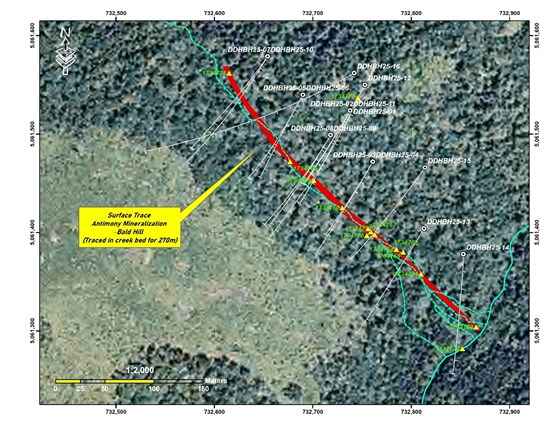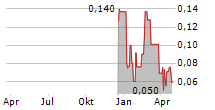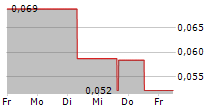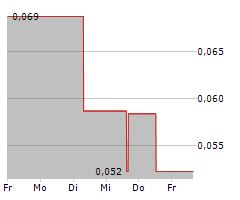Vancouver, British Columbia--(Newsfile Corp. - August 28, 2025) - Antimony Resources Corp. (CSE: ATMY) (FSE: K8J0) (the "Company" or "Antimony Resources" or "ATMY") reports that final assays have been received for an additional seven drill holes at Bald Hill Antimony Project in New Brunswick, Canada.
Drilling Highlights
- High-grade antimony assays have been returned from all drill hole.
- Drill Hole BH-25-10 returned a 8.5 meter wide zone of anomalous Antimony (Sb) with two zones of higher grade - 1.15% Sb over 0.7m and 0.72% Sb over 1.1 m at a depth of 254.9 to 264.35 meters (m).
- Drill Hole BH-25-11 returned two zones - 2.23% Sb over 1.8m at a depth of 132.2 to 134.0 meters and 4.95% Sb over 5.27 m at a depth of 140.35 to 145.3 m.
- Drill Hole BH-25-12 returned antimony-bearing stibnite in five zones including 7.6% Sb from 251.2 to 251.45 and 5.82% Sb from 255.45 to 258.41. This was a deep test of the Main Zone.
- Drill Hole BH-25-13 intersected antimony -bearing stibnite from 36.4 to 43.76 that ran 1.11 % Sb including 5.55 % Sb from 39.45 to 40.80.
- Drill Hole BH-25-14 Returned 1.8% Sb over 3.55 meters.
Both drill hole BF-25-13 and BH-25-14 were drilled to test the southern extension of the Main Zone and were successful in extending the zone over 100 meters in that direction. - Drill Hole BH-25-15 intersected 8.6 meters of antimony bearing stibnite mineralization from 105.3 to 113.9 meters grading 0.58% Sb with higher grade zones of 1.96% Sb and 1.95% Sb over one meter.
- Drill Hole BH-25-16, which is the deepest drill hole completed on the Property to date intersected the Main Zone at a depth of 400 meters and encountered 5.2 meters of 0.53% Sb with 1.5 meters of 1.21 % Sb. This hole was stopped due to excessive deviation and ended in mineralization.
Table 1 below shows the details of assays from the latest drill holes.
| Hole Number | From | To | Length | % Sb |
| BH-25-10 | 254.90 | 263.35 | 8.45 | Anomalous |
| Including | 254.90 | 255.60 | 0.70 | 1.15 |
| and | 263.25 | 264.35 | 1.10 | 0.72 |
| BH-25-11 | 132.20 | 134.00 | 1.80 | 2.23 |
| and | 140.35 | 145.30 | 4.95 | 5.27 |
| BH-25-12 | ||||
| 30.00 | 30.40 | 0.40 | 19.00 | |
| 222.45 | 224.20 | 0.35 | 1.17 | |
| 245.20 | 258.10 | 12.90 | 0.66 | |
| including | 245.20 | 245.60 | 0.40 | 1.99 |
| including | 251.20 | 251.45 | 0.25 | 7.60 |
| and | 255.45 | 258.10 | 2.65 | 5.82 |
| BH-25-13 | ||||
| 36.40 | 43.76 | 7.36 | 1.11 | |
| including | 39.45 | 40.80 | 1.35 | 5.55 |
| BH-25-14 | 45.25 | 48.80 | 3.55 | 1.8 |
| BH-25-15 | 105.30 | 113.90 | 8.60 | 0.58 |
| including | 109.10 | 110.10 | 1.00 | 1.96 |
| and | 112.90 | 113.90 | 1.00 | 1.65 |
| BH-25-16 | 395.00 | 400.20 | 5.20 | 0.53 |
| including | 398.70 | 400.20 | 1.50 | 1.21 |
Table 1: Assay Results for Recently Released Drill Holes at Bald Hill Main Zone.
Phase One drilling has been completed with a total of 3,150 meters in 16 drillholes.
Antimony bearing stibnite mineralization has been outlined in outcrop and drilling. As a result of the recent Phase One Program, the Main Zone now has been shown to extend for a distance of over 400 meters and to a depth of 400 meters.
The location of the drill holes and surface occurrences are shown in Figure 1 below:

Figure 1: Drillhole Locations on the Bald Hill Antimony Main Zone. Note the location of drill holes BH-15-10 to BH-25-16. Yellow triangles represent locations of massive stibnite occurrences on surface. The surface trace of the mineralization is shown in red while drill hole locations are shown by circles. Note: only the drill holes in Antimony Resources recently completed Phase One Program are shown for clarity.
To view an enhanced version of this graphic, please visit:
https://images.newsfilecorp.com/files/8411/264256_6da85998d4d758cc_002full.jpg
The mineralization encountered is described as consisting of massive antimony-bearing stibnite, veins and stibnite bearing breccia. The breccia contains fragments of the enclosing rocks - metasediments and metavolcanics.
On surface the vein/breccia system strikes NNW and dips vertically to steeply to the southwest. The rock units in the area strike to the northeast with the situation that the stibnite-bearing structures cut across the surrounding units at a very oblique angle. Changes in the nature of the Breccia and mineralization are noted as the zone crosses different rock units, but this has not been systematically evaluated. Mineralization is surrounded by alteration consisting of sericite, quartz and carbonate.
Detailed assay results
Assay results were received for seven drill holes numbered BH-25-10 to BH-25-16. Details of the mineralized zones are outlined in the tables below.
Table 2 summarizes assays form drill hole BH-25-10. Note that there are two zones of higher-grade antimony separated by a zone of anomalous antimony with a thickness of over 8.5 meters.
| BH-15-10 | From (m) | To (m) | Length (m) | Sb (%) |
| 254.9 | 264.9 | 9.45 | 0.22 | |
| Including | 254.90 | 255.60 | 0.70 | 1.15 |
| and | 263.25 | 264.35 | 1.10 | 0.72 |
Table 2: BH-25-10
Table 3 details of the mineralized section in drill hole BH-25-11. Note that there are two zones of higher-grade antimony (from 132.2 m to 134.0 m and 140.35 m to 145.3 m) separated by a zone of lower grade.
| BH-25-11 | From (m) | To (m) | Length (m) | Sb (%) |
| 132.20 | 134.00 | 1.80 | 2.23 | |
| and | 140.35 | 145.30 | 4.95 | 5.27 |
Table 3: BH-25-11
Drill hole BH-25-12 summarized in Table 4 below shows assays from two zones - shallow and deep.
| BH-25-12 | From (m) | To (m) | Length (m) | Sb (%) |
| Upper | 30.00 | 30.40 | 0.40 | 19.00 |
| Lower | 222.45 | 224.20 | 0.35 | 1.17 |
| Lower #2? | 245.20 | 258.10 | 12.90 | 0.66 |
| including | 245.20 | 245.60 | 0.40 | 1.99 |
| including | 251.20 | 251.45 | 0.25 | 7.60 |
| and | 255.45 | 258.10 | 2.65 | 5.82 |
Table 4: BH-25-12
Table 5 summarizes mineralized sections for shallow drill hole BH-25-13 and was completed to test the mineralized zone to the southeast beneath a surface exposure discovered during our prospecting program.
| BH-25-13 | From (m) | To (m) | Length (m) | Sb (%) |
| 36.40 | 43.76 | 7.36 | 1.11 | |
| including | 39.45 | 40.80 | 1.35 | 5.55 |
Table 5: BH-25-13
The assay results for drillhole BH-25-14 are reported in Table 6 below.. This hole was also drilled to the southeast of the Main Zone and resulted in an extension of mineralization over 100 meters in that direction.
| BH-25-14 | From (m) | To (m) | Length (m) | Sb (%) |
| 45.25 | 48.80 | 3.55 | 1.8 |
Table 6: BH-25-14
Table 7 contains the details of the mineralized sections for drill hole BH-25-15 with two higher-grade antimony-bearing stibnite mineralization zones intersected at a depths of 109.1 to 110.0 meters and 112.9 to 113.9 meters.
| BH-25-15 | From (m) | To (m) | Length (m) | Sb (%) |
| 105.30 | 113.90 | 8.60 | 0.58 | |
| including | 109.10 | 110.10 | 1.00 | 1.96 |
| and | 112.90 | 113.90 | 1.00 | 1.65 |
Table 7: BH-25-15
Table 8 contains the results from BH-25-16 which is the deepest hole in the program and tested the Main Zone at a depth over 400 meters. The drill hole was terminated at 407 meters even though there was mineralization at this depth because of excessive deviation of the hole.
| BH-25-16 | From (m) | To (m) | Length (m) | Sb (%) |
| 395.00 | 400.20 | 5.20 | 0.53 | |
| including | 398.70 | 400.20 | 1.50 | 1.21 |
Table 8: BH-25-16
The measured drill hole intersections reported are not true widths. True widths have not yet been accurately determined but are estimated to be between 75% and 80% of the intersected lengths.
Jim Atkinson, P. Geo., CEO of Antimony Resources Corp, stated: "The Phase One drilling program at Bald Hill has been completed and we are very pleased with the results. Significant high-grade antimony has been intersected in over 75% of our drillholes. We are working with consultants to prepare an updated 3-D Model which will assist us in the next phase of exploration and be used to determine the continuity and distribution of the zones of antimony mineralization. This information will guide us in our on-going drilling and in the determination of our ability to complete a Maiden resource. Our recent drilling extended the Main Zone by over 100 meters to the southeast and to a depth of at least 400 meters, significantly expanding the potential of the deposit. As previously described, the results obtained in our drilling and prospecting have increased our confidence in the validity of the previous drilling results and will assist in establishing the drill hole density we will need to calculate a Mineral Resource. We will be working with consultants to discuss the appropriate drill density, continuity etc. for resource calculations. We are very excited to be preparing for the commencement of our next phase of exploration drilling which should begin in Mid-September. This program will include exploration on the wider property."
Bald Hill Antimony Project
Highlights from Past exploration
- Bald Hill is a well-known, high-grade antimony deposit in southern New Brunswick
- Past work including drilling has outlined an antimony deposit over 500 m. long
- Widths of mineralization average 3 to 4 meters and grades average 3% to 4% antimony.
- Historical NI-43-101 Technical Report: Potential quantity and grade of the drilled area, which is the target of our exploration, is in the 725,000 to 1,000,000 tonne range grading 4.11% to 5.32% Sb (~30,000 to 40,000 tonnes contained antimony)1
- Potential to expand based on additional known targets
The Bald Hill Antimony Property
The property is located approximately equal distance from Sussex, Fredericton and St John in southern New Brunswick. Access is very good with provincial and regional highways crossing and adjacent to the property. Drilling can be completed year-round. Including the recent drilling program there has been over 9,600 meters of drilling completed on the project.
The Main Zone of the deposit consists of at least three antimony-bearing breccias and hydrothermal veins zones trending northwesterly. Mineralization has been defined over a 700-meter strike length to a vertical depth of 300 meters and is open in all directions and to depth. High Grade antimony has been encountered in drilling including recent intersections. The discovery Hole DDH08-03 intersected 4.51m at a grade of 11.7% Antimony (Sb) including 2.29m grading 20.9% Sb. Recent drilling has duplicated these results and extended the mineralized zone to the southeast and to depth.
A possible extension of the Main Zone was discovered in 2014. Trenching approximately 450 meters south of Main Zone returned values of 2.90% Sb over 8.18m, which included 5.79% Sb over 1.75m and 8.47% over 1.53m. Drilling in this area confirmed the presence of antimony bearing stibnite mineralization similar to the Main Zone which has not been sufficiently explored. We will focus part of the upcoming program in this area.
The exploration plan in 2025 was to complete at least 2,500 meters of diamond drilling to explore the known mineralized zone, extend the mineralization to the north and south and down dip and expand parallel veins discovered in the past. In fact, over 3100 meters were completed and the goal of expanding the mineralized zone was accomplished. It is hoped that the completed and planned drilling programs will allow us to calculate a Maiden Resource by the end of the year.
An historical NI 43-101 technical report, prepared by CRA in 20101, identified the potential for between 705,000 and 1,000,000 metric tonnes at an average grade between 4% and 5% antimony (Sb)1). - Antimony Resources Corp. has not completed enough work to confirm this estimate. The potential quantity and grade are conceptual in nature as there has been insufficient exploration to define a mineral resource, and it is uncertain if further exploration will result in the target being delineated as a mineral resource.
The technical contents of this news release were reviewed and approved by Jim Atkinson, MSc., P.Geo., who is a qualified person as defined by National Instrument 43-101.
Sampling Procedures - Quality Assurance/Quality Control
Analytical services were provided by Actlabs, which is an independent, CALA- and SCC-accredited analytical services firm registered to ISO 17025 and ISO 9001 standard. NQ drill core samples were logged and split in half with a diamond core saw. Half-core samples were securely stored at the core logging facility until being delivered to Actlabs Fredericton lab by staff of ATMY. Samples were crushed (< 7 kg) up to 90% passing 2mm (10 mesh), riffle split to 250 g and pulverized by mild steel to 95% passing 105µm (150 mesh). Samples splits underwent a 4-acid near total digestion followed by a multi-element analysis, including base metals, using an ICP method for 35 elements. Result over the detection limits were rerun using assay techniques.
Antimony Resources conducted a comprehensive QA/QC program for the analysis comprising approximately 20% for each batch including: one sample of certified reference material, one sample duplicate of split core, one pulp duplicate taken at the lab and one blank sample for each batch of 25 samples.
The Laboratory also completed QA/QC procedures including duplicates, method blanks and standards. An additional 13% QA/QC was performed as part of the instrumental analysis to ensure quality in the areas of instrumental drift.
About Antimony Resources Corp. (CSE: ATMY) (FSE: K8J0)
Antimony Resources Corp. is an exploration and development company focused exclusively on Antimony. The Company's management team possesses extensive experience in financing, exploration, development and mining. The Company is focused on becoming a significant North American producer of antimony.
www.antimonyresources.com
On Behalf of the Board of Directors
Jim Atkinson, CEO and President
647 278 7502
For further information, please contact:
Anthony Simone, President, Simone Capital Inc.
416-881-5154, asimone@simonecapital.ca
1 NATIONAL INSTRUMENT 43-101 TECHNICAL REPORT BALD HILL ANTIMONY PROJECT SOUTHERN NEW BRUNSWICK, CANADA prepared by: Conestoga-Rovers & Associates MAY 2010 REF. NO. 070813 (1)
To view the source version of this press release, please visit https://www.newsfilecorp.com/release/264256
SOURCE: Antimony Resources Corp.



